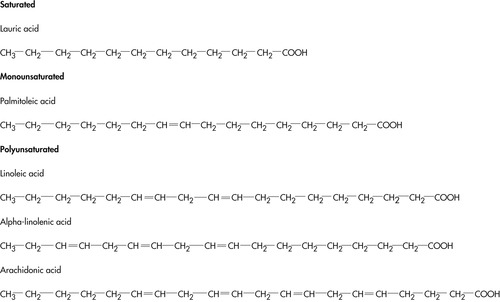Chapter 3. Fats
Dietary fat is part of a heterogeneous group of compounds known as the lipids. These compounds are classified together because of their solubility in organic solvents and their insolubility in water. They can be further categorized into simple lipids, compound lipids, and derived lipids. The simple lipids include the triglycerides, which are the most common form of fat present in the diet, and the waxes. Triglycerides are made up of three fatty acids linked to one molecule of glycerol (Figure 3-1), and waxes contain a greater number of fatty acids linked to a long-chain alcohol molecule. Compound lipids are composed of a lipid, such as a fatty acid, linked to a nonlipid molecule. Lipoproteins, which function to carry fat in the bloodstream, are a type of compound lipid. The derived lipids include sterol compounds, such as cholesterol, and fat-soluble vitamins.
 |
| Figure 3-1 |
Triglyceride is the most important type of fat in the diet; it can be differentiated in foods according to the types of fatty acids that each triglyceride contains. Fatty acids vary in carbon-chain length and may be saturated, monounsaturated, or polyunsaturated. Most food triglycerides contain predominantly long-chain fatty acids that have an even number of carbon atoms ranging between 16 and 26. Two exceptions are butter and coconut oil, which contain appreciable amounts of medium- and short-chain fatty acids (SCFAs). Medium-chain triglycerides (MCTs) refer to triglycerides that primarily contain fatty acids with between 8 and 10 carbon atoms. These fatty acids have been shown to be rapidly hydrolyzed and absorbed in human subjects, reportedly directly entering the portal venous blood system rather than being transported through the lymphatic system. 1 For this reason, MCTs have been identified as a form of dietary fat that may provide benefit to dogs with digestive disorders that affect normal fat digestion and absorption. 2 However, a study that examined the digestion and absorption of MCTs in healthy adult dogs found evidence that these fats were absorbed in the same manner as long-chain fatty acids (via that intestinal lymphatic system) and found no evidence of direct transport via portal venous blood. 3 In addition, others have reported that the inclusion of high concentrations of MCTs in dog diets can negatively affect diet palatability and cause reduced food intake. 2. and 4. Therefore additional studies of benefits for this class of fats for pets with gastrointestinal disease are warranted before their use in therapeutic diets can be recommended.
Saturated fatty acids contain no double bonds between carbon atoms and thus are “saturated” with hydrogen atoms. Monounsaturated fatty acids have one double bond, and polyunsaturated fatty acids (PUFAs) contain two or more double bonds (Figure 3-2). The double bonds between carbon atoms in unsaturated fatty acids may exist in either cis or trans configurations. Cis isomers have the hydrogen atoms on each side of the double bond oriented in the same plane, while trans isomers have their hydrogen atoms on each side of the bond oriented in opposite planes. Most of the naturally occurring unsaturated fatty acids are cis isomers. Conversely, trans double bonds are most commonly introduced into fatty acids during the food manufacturing process (both in human and pet foods) or hydrogenation. In humans, the inclusion of trans fatty acids in the diet can negatively affect lipoprotein metabolism in the same manner as diets that are rich in saturated fat. 5 However, the impact of these fats upon canine and feline fat metabolism and health has not been studied extensively. In general, the triglycerides in animal fats contain a higher percentage of saturated fatty acids than do those in vegetable fats. Most plant oils, with the exception of palm, olive, and coconut oils, contain between 80% and 90% unsaturated fat; animal fats contain between 50% and 60% unsaturated fat.
 |
| Figure 3-2 |
Fat has numerous functions within the body. Triglycerides are the body’s primary form of stored energy. Major depots of fat accumulation are present under the skin (as subcutaneous fat), around the vital organs, and in the membranes surrounding the intestines. Some of these depots can be readily observed in obese dogs and cats. Fat depots in the body have an extensive blood and nerve supply and are in a constant state of flux, providing energy in times of need and storage in times of energy surplus. They also serve as insulators, protecting the body from heat loss, and as a protective layer that guards against physical injury to the vital organs. Although animals have a very limited capacity to store carbohydrate in the form of glycogen, they have an almost limitless capacity to store surplus energy in the form of fat.
In addition to providing energy, fat has numerous metabolic and structural functions. Fat insulation surrounds myelinated nerve fibers and aids in the transmission of nerve impulses. Phospholipids and glycolipids serve as structural components for cell membranes and participate in the transport of nutrients and metabolites across these membranes. Lipoproteins provide for the transport of fats through the bloodstream. Cholesterol is used by the body to form the bile salts necessary for proper fat digestion and absorption, and it is also a precursor for the steroid hormones. Along with other lipids, cholesterol forms a protective layer in the skin that prevents excessive water loss and the invasion of foreign substances. The essential fatty acid (EFA) arachidonic acid is the precursor of a group of physiologically and pharmacologically active compounds called prostacyclins, prostaglandins, leukotrienes, and thromboxanes. These compounds perform extensive hormonelike actions in the body and are involved in processes such as vasodilation and vasoconstriction, muscle contraction, blood pressure homeostasis, gastric acid secretion, regulation of body temperature, regulation of blood clotting mechanisms, and control of inflammation.
< div class='tao-gold-member'>
Only gold members can continue reading. Log In or Register to continue
Stay updated, free articles. Join our Telegram channel

Full access? Get Clinical Tree


